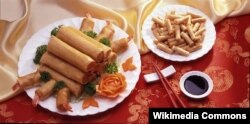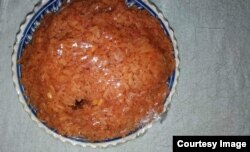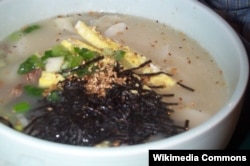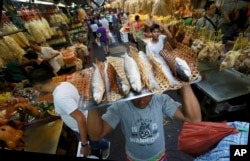The Lunar New Year begins February 16. It is one of the biggest and most important holidays in Asia.
In China, it is called “chun jie.” In Vietnam, it is known as “Tet.” And in Korea, it is “Seollal.”
While the names may be different, these and other countries mark the coming year with many similar activities: family reunions, festivals, cleaning and organizing the home, the color red, and -- of course -- traditional foods.
Today, we learn about five foods considered lucky during the Lunar New Year.
Spring rolls
The Chinese name for the holiday means “spring festival” in English. And spring rolls -- a common New Year’s food – are named in honor of the holiday.
Spring rolls are often made of finely cut vegetables, such as carrots and cabbage, and pork meat. They are wrapped in dough that turns crispy and golden as it fries. To fry is to cook in oil over high heat.
The fried spring rolls are said to look like large pieces of gold. The food is a symbol of wealth and financial success for the coming year.
Vietnamese red sticky rice
In Vietnam, one food you will find during Tet is orange-red sticky rice. The special dish is called xoi-gac. It is made with gac, a fruit that only grows in Asia. In English, it is known as baby jackfruit.
The inside of the fruit is a beautiful, deep red. This gives xoi-gac its orange-red color. And it is the food's color that makes it especially popular during Tet; red represents luck, happiness and celebration in many Asian cultures.
Xoi-gac is made by steaming white sticky rice with the fruit, coconut milk and sugar. The result is an exceptional, sweet taste.
Korean rice cake soup
No Korean New Year celebration is complete without tteokguk, or rice cake soup.
Eating a bowl of it is said to bring a person a long life. Eating tteokhuk also represents growing another year older. In fact, Koreans may ask a person their age by saying “how many bowls of tteokguk have you eaten?”
The soup includes broth, vegetables and thin, round pieces of rice cake. The round shape it said to symbolize old Korean money. So, tteokguk is said to bring riches, too.
Radish cake
While Koreans celebrate the New Year with rice cake, people in Taiwan do it with radish cake. A big reason? In the Hoklo language spoken in Taiwan, the words for “radish” and “good fortune” are homophones, or words with different meanings that sound the same.
Radish cake is made with thinly cut pieces of radish, rice flour, fatty meat, spices, shrimp and dried mushrooms. It is cut into pieces and fried. The result is a savory snack.
This dish can be easily found all year long. But, it is said to bring good luck for the next 12 months if you eat radish cake around the Lunar New Year.
Fish
In many places in Asia, fish is another lucky food for the New Year. And there is another homophonic connection in China. The Mandarin word for fish (yu) sounds like the word for surplus, which means more or extra.
So, fish also symbolizes wealth. As a New Year's dish, it is often steamed with ginger and soy sauce and topped with greens, like cilantro and spring onions.
But do not eat all of the fish. To be especially lucky, there should be some left for a meal the next day. That suggests your riches will continue throughout the new year.
Happy New Year to all!
I’m Ashley Thompson.
And I’m Caty Weaver.
Do you celebrate the Lunar New Year? If so, what are some of the lucky or traditional New Year foods where you live? Let us know in the comments section!
_________________________________________________________________
Words in This Story
dough - n. a mixture of flour, water, and other ingredients that is baked to make bread, cookies, etc.
steam - v. to cook, heat, or treat (something) with steam
crispy - adj. pleasantly thin, dry, and easily broken
broth - n. liquid in which food (such as meat) has been cooked
symbolize - v. to be a symbol of (something)
savory - adj. having a spicy or salty quality without being sweet
snack - n. a small amount of food eaten between meals












